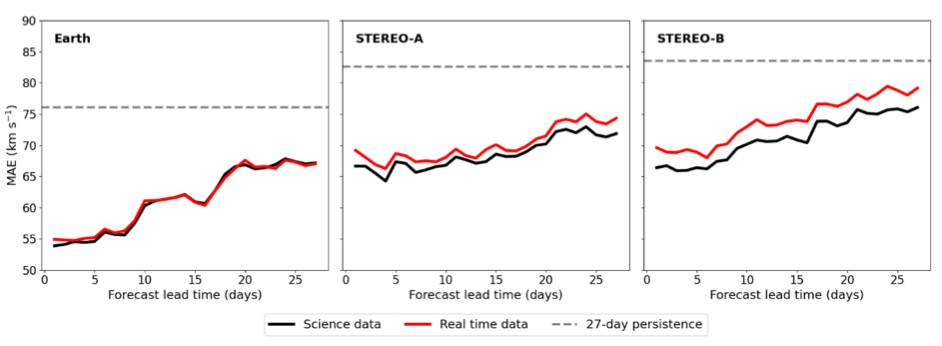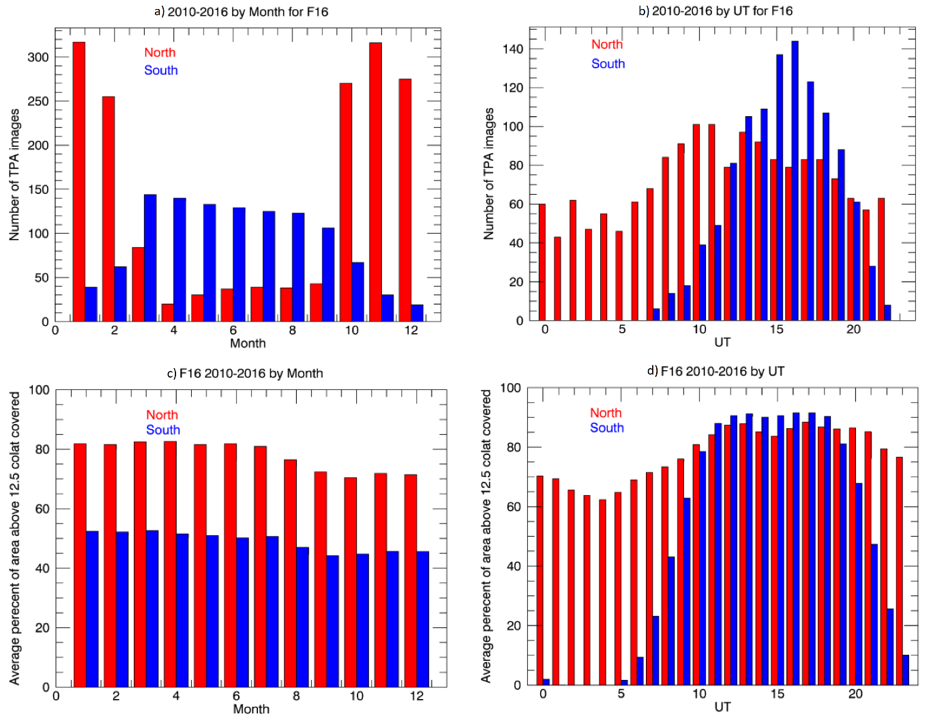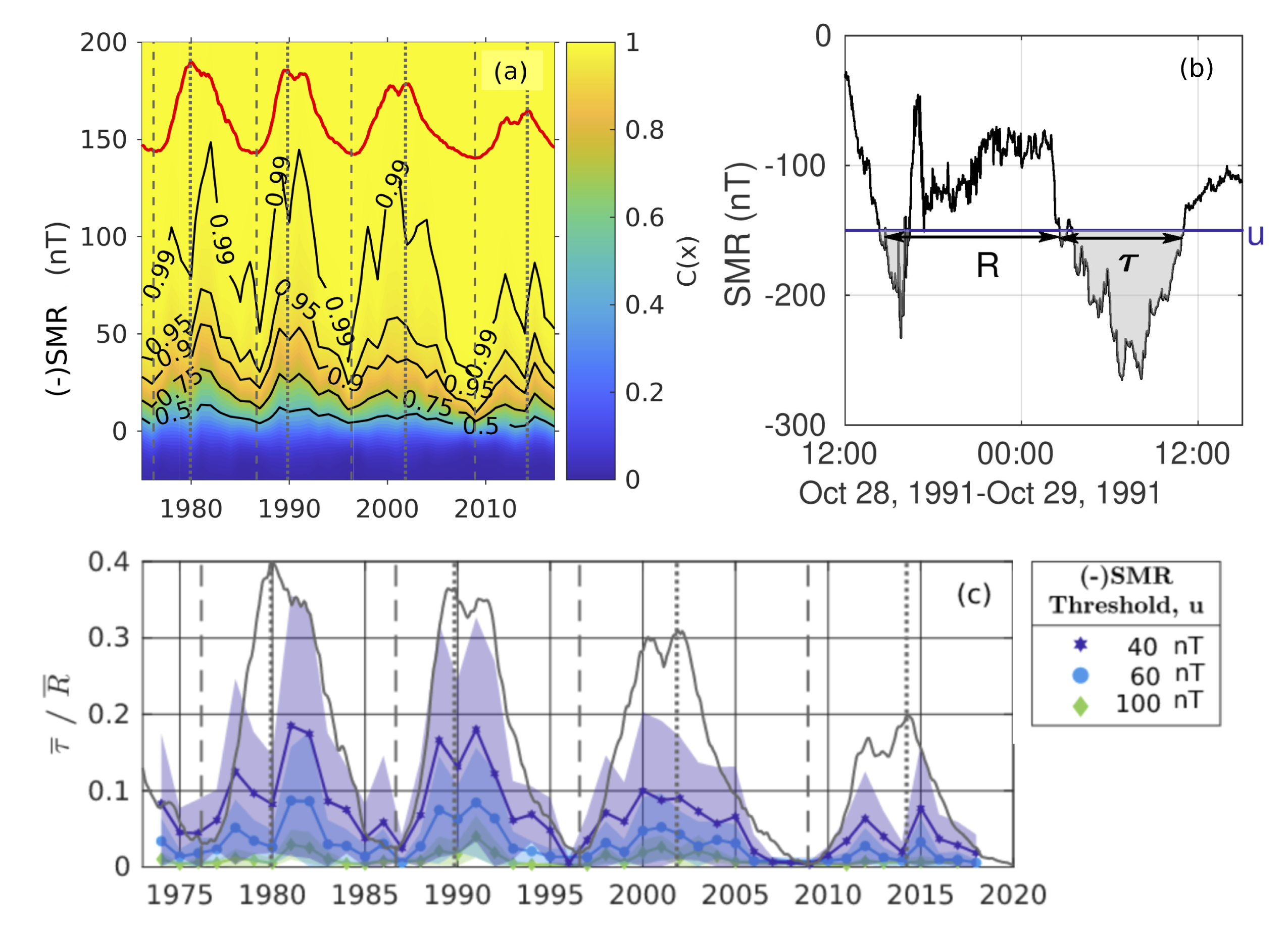MIST
Magnetosphere, Ionosphere and Solar-Terrestrial
Nuggets of MIST science, summarising recent papers from the UK MIST community in a bitesize format.
If you would like to submit a nugget, please fill in the following form: https://forms.gle/Pn3mL73kHLn4VEZ66 and we will arrange a slot for you in the schedule. Nuggets should be 100–300 words long and include a figure/animation. Please get in touch!
If you have any issues with the form, please contact This email address is being protected from spambots. You need JavaScript enabled to view it..
Data Assimilation and the Solar Wind
By Harriet Turner (University of Reading)
Data assimilation (DA) combines model output and observations to form an optimal estimation of reality. It has led to large improvements in terrestrial weather prediction, reducing the “butterfly effect”, by which small errors in the initial conditions can grow non-linearly and lead to large errors in the subsequent forecast.
DA has been used in three main areas for space weather forecasting: the ionosphere, the photosphere, and, more recently, the solar wind. The first attempts at using DA for solar wind forecasting has shown promise, with a reduction in forecast error (Lang, 2021).
I have been using the Burger Radius Variational Data Assimilation (BRaVDA) scheme (Lang, 2019). This uses output from a coronal model with a computationally efficient solar wind model (HUX; Riley and Lionello, 2011) to map information from in-situ observations at Earth’s orbital radius (215 solar radii), back to the HUX inner boundary at 30 solar radii. The inner boundary conditions are then updated, given the information from the in-situ observations. This update is then run forward in time, again using HUX, to produce a reconstruction of the solar wind. This can then be used for forecasting.
We have three sources of observations: STEREO-A, STEREO-B, and the OMNI dataset for near-Earth space. For the purposes of my work, I am using a simple corotation to produce a forecast. We can compare this forecast against observations from the three sources to assess its performance. Recently, I have been looking at testing the performance of BRaVDA with real time data. Previous experiments have used cleaned-up, science-level data, but real time data would need to be used for an operational DA scheme. Initial results show that using the real time data does not worsen the forecasts significantly and is still an improvement from a 27-day persistence forecast, as shown in Figure 1, which is promising for future implementation of solar wind DA.

Figure 1: Mean absolute error (MAE) of solar wind forecasts as a function of forecast lead time, for the case where OMNI, STEREO-A and STEREO-B observations are assimilated together. The black line shows the forecast where the science-level data was used and the red line when real time data was used. The dashed grey line shows the average 27-day persistence MAE for the specific spacecraft. The left-hand panel shows the forecast at Earth, the middle panel shows the forecast at STEREO-A and the right-hand panel shows the forecast at STEREO-B. This covers the period from 01/04/2012 to 01/10/2013.
References:
Lang, M., & Owens, M. J. (2019). A Variational Approach to Data Assimilation in the Solar Wind. Space Weather, 17(1), 59 – 83. Doi: 10.1029/2018SW001857.
Lang, M., Witherington, J., Owens, M. J., & Turner, H. (2021). Improving solar wind forecasting using data assimilation. Space Weather, 1 – 23.
Riley, P., & Lionello, R. (2011). Mapping Solar Wind Streams from the Sun to 1 AU: A Comparison of Techniques. Solar Physics, 270(2), 575 – 592. Doi: 10.1007/s11207-001-9766-x.
Assessing the Impact of Weak and Moderate Geomagnetic Storms on UK Power Station Transformers
By Zoë Lewis (Imperial College London)
Geomagnetically induced currents (GICs) are known to cause damage to power station transformers, as they can flow through the grounded neutral and generate extra magnetic flux, causing localised heating. This heating can break down the insulation and cooling oil that surrounds the core, so can be measured through small changes in the concentrations of dissolved gases within the oil.
In this work, we analysed dissolved gas data from 13 UK based transformers during geomagnetic storms from 2010-2015. We used a list of storms outlined in [1] and looked for an increase in the levels of carbon monoxide, hydrogen, and methane at the onset of the storm, as well as any correlation between the rate of gas increase and the SYM-H index. We also used the Low Energy Degradation Triangle (LEDT) method [2] as a measure of degradation.
Figure 1 shows the results of a superposed epoch analysis (SEA) for carbon monoxide, methane and hydrogen in one transformer. The epochs are centred on the start of the main phase of each storm, as defined in [1]. There is no systematic increase in the gas concentrations at the storm onset or in the following days. The interquartile range (shaded blue) is also very large owing to the highly variable data.
We conclude that during this period, the transformers studied were unaffected by space weather events. However, it is noted that 2010-2015 lies within a relatively quiet solar cycle, and there were no storms in this period that would be considered large on the scale of the past few decades. Therefore, in future work it would be desirable to expand this study to look at a more geomagnetically active period.

[1] Walach, M. T., & Grocott, A. (2019). SuperDARN Observations During Geomagnetic Storms, Geomagnetically Active Times, and Enhanced Solar Wind Driving. Journal of Geophysical Research: Space Physics, 124 (7), 5828–5847. doi: 10.1029/2019JA026816
[2] Moodley, N., & Gaunt, C. T. (2017). Low Energy Degradation Triangle for power transformer health assessment. IEEE Transactions on Dielectrics and Electrical Insulation, 24 (1), 639–646. doi: 10.1109/TDEI.2016.006042
Please see paper for full details: , , , & (2022). Assessing the impact of weak and moderate geomagnetic storms on UK power station transformers. Space Weather, 20, e2021SW003021. https://doi.org/10.1029/2021SW003021
Transpolar Arcs: Seasonal Dependence Identified by an Automated Detection Algorithm
By Gemma E Bower (University of Leicester)
Transpolar arcs (TPAs) are primarily a northward IMF auroral phenomena. They consist of an arc of auroral emission poleward of the main auroral oval. Their presence suggests that the magnetosphere has a complicated magnetic topology. Currently, TPA formation and evolution have no single explanation that is unanimously agreed upon.
In order to further study the occurrence of TPAs we have developed an automated detection algorithm to determine the occurrence of TPAs in UV images captured by the Defense Meteorological Satellite Program/ Special Sensor Ultraviolet Spectrographic Imager (DMSP/SSUSI) from spacecraft F16, F17, and F18. The detection algorithm identified TPAs as a peak in the average radiance intensity poleward of 12.5° colatitude, in two or more of the wavelengths/bands sensed by SSUSI.
Over 5,000 SSUSI images containing TPAs were identified by the detection algorithm between the years 2010 to 2016. Figure 1a and b shows the seasonal and UT distribution for the F16 TPA images respectively. The occurrence of these TPA images shows a seasonal dependence, with more arcs being visible in the winter hemisphere. There is also an apparent dependence on time-of-day, especially in the southern hemisphere where no TPAs are seen between 23 and 06 UT.
We investigated the effect that the orbital plane of DMSP has on the area of the detection window scanned, as a possible explanation of the dependences in the results of the detection algorithm. Figure 1c and 1d show the results for F16 for seasonal and UT distribution respectively. It can be seen that the orbital plane of DMSP leads to a preferential observation of the northern hemisphere, and the detection algorithm missing TPAs in the southern hemisphere around 01–06 UT. Hence, we conclude that there is no dependence of TPA occurrence on UT. No seasonal bias in the observations is found, indicating that the seasonal dependence of the TPA occurrence is real. We discuss the ramifications of these findings in terms of proposed TPA generation mechanisms.

Figure 1: (a-b) Number of transpolar arc (TPA) images identified by F16 between 2010 and 2016. (c-d) Average percent of the detection window poleward of 12.5° colatitude scanned by F16 between 2010 and 2016. (a and c) By month. (b and d) By UT. The northern hemisphere is red and the southern hemisphere is blue
Please see paper for full details: Bower, G. E., Milan, S. E., Paxton, L. J., & Imber, S. M. (2022). Transpolar arcs: Seasonal dependence identified by an automated detection algorithm. Journal of Geophysical Research: Space Physics, 127, e2021JA029743. https://doi.org/10.1029/2021JA029743
Variation of Geomagnetic Index Empirical Distribution and Burst Statistics Across Successive Solar Cycles
By Aisling Bergin (University of Warwick)
Geomagnetic indices, based on magnetic field observations at the Earth's surface, provide almost continuous monitoring of Earth’s magnetospheric and ionospheric activity. We analyze two geomagnetic index time series, AE and SMR, which track activity in the auroral region and around the Earth's equator, respectively. We show here that quantiles of the index distributions track solar cycle variation over solar cycles 21–24. The question is then how the likelihood of events varies with solar cycle activity.
In this paper, events are defined as bursts or excursions above a threshold which is either (i) a fixed value or (ii) a quantile of the distribution of the observed index values. We study the solar cycle dependence of the distributions of the burst return periods, R, and the burst durations, τ. A result from the theory of level crossings (LC) [1] constrains how , the ratio of the mean burst duration to return period, depends on the underlying empirical distribution of the observed quantity.
Our main results are as follows:
- At fixed value burst thresholds, is peaked in the declining phase for AE annual samples and follows the sunspot number double peak for SMR.
- Bursts are identified in samples at three distinct phases of the solar cycle. At fixed quantile thresholds the distributions of τ and R fall on single empirical curves for each of (i) the AE index at solar minimum, maximum, and declining phase and (ii) the SMR index at solar maximum. This goes beyond the constraint on average from LC theory.
- The tail of the empirical cumulative distribution functions of the observed values of the AE and SMR indices collapse onto common functional forms specific to each index and cycle phase when normalized to the first two moments of their exceedance distributions.
Taken together, these results may combine to offer important constraints in the quantification of overall space weather activity levels.

Please see the paper for full details: Bergin, A., Chapman, S. C., Moloney, N. R., & Watkins, N. W. (2022). Variation of geomagnetic index empirical distribution and burst statistics across successive solar cycles. Journal of Geophysical Research: Space Physics, 127, e2021JA029986. https://doi.org/10.1029/2021JA029986
[1] Lawrance, A., & Kottegoda, N. (1977). Stochastic modelling of riverflow time series. Journal of the Royal Statistical Society: Series A, 140(1), 1–31. https://doi.org/10.2307/2344516
Saturn's Weather‐Driven Aurorae Modulate Oscillations in the Magnetic Field and Radio Emissions
By Nahid Chowdhury (University of Leicester)
Planetary parameters at Saturn have exhibited mysterious time variabilities and periodicities for almost two decades. After the first Voyager measurements of the 1980s led to a determination of a rotation rate for the ringed planet, the advent of the Cassini mission in the 2000s showed that the measured length of a day at Saturn was subject to change. Numerous theories were proposed to explain the time variabilities seen in planetary parameters ranging from the radio emission through to the energies of neutral atoms and these fell into one of two general categories. The first was that a driving mechanism for the observed periodic behaviour would be situated externally to the planet, within the magnetosphere. The second was that a driving mechanism would be situated within the planet’s atmosphere.
Using infrared observations of Saturn’s northern polar auroral H3+ emission taken with Keck-NIRSPEC in 2017, we investigated ion flows in our search for a signature of the twin-vortex mechanism in the planet’s upper atmosphere that was purported to drive the observed periodicities. H3+ is an ion found in the ionosphere of gas giant planets and measurements of its line-of-sight velocity are indicative of the more general motion of constituents in the planet’s atmosphere.
By grouping our spectral data into quadrants of local northern planetary magnetic phase, we set up our experiment to probe the ion flows driven by the planetary period current. This led to the astonishing detection of the proposed ionospheric twin-vortices that are considered to be responsible for the periodicities witnessed throughout Saturn’s planetary and magnetospheric environments. Our observations show that local atmospheric weather effects at Saturn drive the twin-vortex flows while also generating some auroral emissions. This result has far-reaching implications for both other planets in our Solar System and exoplanetary systems.

Figure caption: Shown here is an example of the type of winds within the upper atmosphere that are driving the ionosphere to move in the way observed in this new paper. This set of two vortices rotate around the pole of the planet, driving currents within the ionosphere, which then reach out into the surrounding magnetosphere, producing the bright aurora and magnetic field changes observed by Cassini. This weather system was originally proposed by Chris Smith in a paper in Monthly Notices of the Royal Astronomical Society in 2011 (doi:10.1111/j.1365-2966.2010.17602.x) – and it is these modelled flows that we show here.
Please see paper for full details: Chowdhury, M.N., Stallard, T.S., Baines, K.H., Provan, G., Melin, H., Hunt, G.J., Moore, L., O’Donoghue, J., Thomas, E.M., Wang, R. and Miller, S., 2022. Saturn's Weather‐Driven Aurorae Modulate Oscillations in the Magnetic Field and Radio Emissions. Geophysical Research Letters, 49(3), p.e2021GL096492. DOI: https://doi.org/10.1029/2021GL096492.